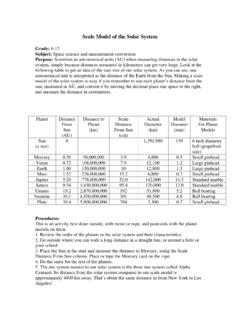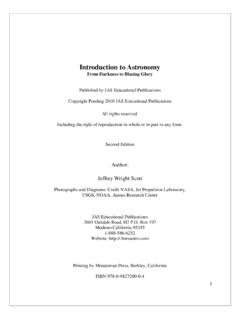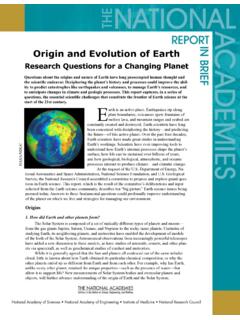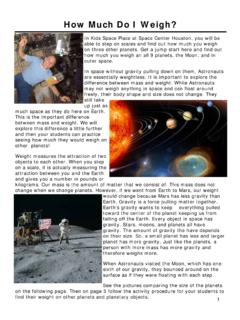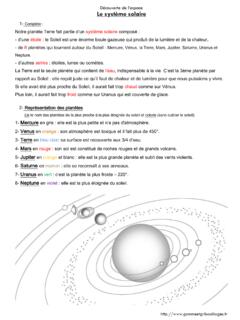Transcription of EARTH SCIENCE Astronomy Regents Questions
1 EARTH SCIENCE Astronomy Regents Questions Name: _____ Period:_____ January 2015 1 The theory that the universe is expanding is supported by data from the (1) nuclear decay of radioactive materials (3) blue shift of light from distant galaxies (2) nuclear fusion of radioactive materials (4) red shift of light from distant galaxies 2 The photograph below shows a feature of the universe as seen through a telescope. 3 Fourteen billion years represents the approximate age of (1) EARTH (2) EARTH s Moon (3) our solar system (4) the universe 4 Which terms describe the motion of most objects in our solar system? (1) noncyclic and unpredictable (3) cyclic and unpredictable (2) noncyclic and predictable (4) cyclic and predictable 5 Which planet has completed less than one orbit of the Sun in the last 100 years? (1) Mars (2) Mercury (3) Neptune (4) uranus 6 Compared to the size and density of EARTH , the Moon has a (1) smaller diameter and lower density(3) larger diameter and lower density (2) smaller diameter and higher density (4) larger diameter and higher density This feature is best identified as (1) a galaxy (2) a comet (3) an asteroid (4) a star 25 Which diagram best represents the regions of EARTH in sunlight on June 21 and December 21?
2 [NP indicates the North Pole and the shading represents EARTH s night side. Diagrams are not drawn to scale.] Base your answers to Questions 36 through 40 on the diagram below and on your knowledge of EARTH SCIENCE . The diagram represents EARTH s revolution around the Sun. Points A, B, C, and D represent EARTH s positions in its orbit on the first day of each of the four seasons. The major axis and the foci (the center of the Sun and the other focus) of EARTH s orbit are shown. 36 Approximately how many days (d) does it take EARTH to travel from position A to position C? (1) 91 d (2) 182 d (3) 274 d (4) 365 d 37 Since EARTH has an elliptical orbit, the (1) distance between the Sun and EARTH varies (3) length of EARTH s major axis varies (2) distance between the Sun and the other focus varies (4) length of EARTH s period of revolution varies 38 At positions A, B, C, and D, the north end of EARTH s axis of rotation is pointing toward (1) Betelgeuse (2) Polaris (3) the center of the Milky Way (4) the center of our solar system 39 The constellation Orion is visible at night in New York State when EARTH is at position A, but not at position C because EARTH s (1) nighttime is shorter when EARTH is at position A (2) period of rotation is shorter than its period of revolution (3) distance to Orion is too great for the constellation to be seen (4)
3 Nighttime side is facing toward a different portion of space 40 At which two positions will an observer in New York State experience approximately 12 hours of daylight during one rotation of EARTH ? (1) A and B (2) A and C (3) B and C (4) B and D Base your answers to Questions 51 through 53 on the graph below and on your knowledge of EARTH SCIENCE . The graph shows the average daily heights above or below sea level of high and low tides from April 15 to May 15, for a New York State location. Five Moon phases are indicated at the dates on which they occurred. 51 On the diagram below, place an X on the Moon s orbit to indicate the Moon s position on April 15. [1] 52 On the diagram below, circle the two numbers on EARTH s surface that best represent the locations of high tide when the Moon is in the position shown on the diagram. [1] 53 Infer the date when the next first-quarter Moon phase occurred.
4 [1] Base your answers to Questions 79 through 82 on the Characteristics of Stars graph below and on your knowledge of EARTH SCIENCE . 79 The star Canopus has a surface temperature of 7400 K and a luminosity (relative to the Sun) of 1413. On the diagram below, use an X to plot the position of Canopus on the graph, based on its surface temperature and luminosity. [1] 80 Identify two stars from the Characteristics of Stars graph that are at the same life-cycle stage as the Sun.[1] 81 Describe one characteristic of the star Spica that causes it to have a greater luminosity than Barnard s Star.[1] 82 Describe how the relative surface temperature and the relative luminosity of Aldebaran would change if it collapses and becomes a white dwarf like Procyon B. [1] August 2014 1 Which evidence best supports the theory that the universe was created by an explosion called the Big Bang? (1) impact craters found on EARTH (3) the different compositions of terrestrial and Jovian planets (2) cosmic background radiation (4) the blue shift of light from distant galaxies 2 Which star is more massive than our Sun, but has a lower surface temperature?
5 (1) 40 Eridani B (2) Sirius (3) Aldebaran (4) Barnard s Star 3 Which color of visible light has the shortest wavelength? (1) violet (2) green (3) yellow (4) red 4 The table below shows the times of ocean high tides and low tides on a certain date at a New York State location. 5 The best evidence of EARTH s rotation is provided by the (1) shape of EARTH s orbit (3) changes in the total yearly duration of insolation at a location on EARTH (2) shape of the Milky Way galaxy (4) apparent changes in the direction of swing of a Foucault pendulum 6 The model below shows the apparent path of the Sun as seen by an observer in New York State on the first day of one of the four seasons. At approximately what time on the following day did the next high tide occur at this location? (1) 4:40 (2) 5:40 (3) 4:40 (4) 5:40 This apparent path of the Sun was observed on the first day of (1) spring (2) summer (3) fall (4) winter Base your answers to Questions 27 and 28 on the diagram below and on your knowledge of EARTH SCIENCE .
6 The diagram represents the Moon at different positions, labeled A, B, C, and D, in its orbit around EARTH . 27 At which two Moon positions would an observer on EARTH most likely experience the highest high tides and the lowest low tides? (1) A and B (2) B and C (3) C and A (4) D and B 28 During which Moon phase could an observer on EARTH see a lunar eclipse occur? 29 The graph below shows the varying amount of gravitational attraction between the Sun and an asteroid in our solar system. Letters A, B, C, and D indicate four positions in the asteroid s orbit. Which diagram best represents the positions of the asteroid in its orbit around the Sun? [Note: The diagrams are not drawn to scale.] Base your answers to Questions 41 through 43 on the passage and diagram below and on your knowledge of EARTH SCIENCE . The passage describes geologic studies of the Moon. The diagram represents the Moon s surface and interior, showing the inferred depth of each layer below the Moon s surface.
7 Moon Studies Scientific instruments left on the Moon s surface recorded 12,558 moonquakes in eight years. Most of these moonquakes originated between 700 km and 1200 km below the Moon s surface. Scientists infer that most moonquakes are caused by the gravitational forces between the Moon, EARTH , and the Sun. 41 The same type of evidence was used to find the inferred depths of both the Moon s interior layers and EARTH s interior layers. What evidence was used to determine the inferred depth of the boundary between the Moon s mantle and core? (1) seismic data recorded on the Moon s surface (3) convection currents mapped in the Moon s mantle and core (2) magnetic data measured on the Moon s surface (4) temperatures measured in the Moon s mantle and core 42 What is the inferred thickness of the Moon s mantle? (1) 60 km (2) 638 km (3) 1040 km (4) 1738 km 43 Which planet has an average density most similar to the average density of the Moon?
8 (1) Mercury (2) Mars (3) Jupiter (4) Neptune Base your answers to Questions 63 through 65 on the diagram below and on your knowledge of EARTH SCIENCE . The diagram represents a model of EARTH s orbit around the Sun. Arrows represent two motions of EARTH . Distances from the center of the Sun to the center of EARTH are indicated in kilometers. EARTH is represented when it is closest to the Sun and when it is farthest from the Sun. 63 On the diagram above, place an X on EARTH s orbit at one location where EARTH s Northern Hemisphere is in winter. [1] 64 How many degrees is EARTH s axis tilted to a line perpendicular to the plane of EARTH s orbit? [1] 65 The diagram below represents EARTH at one position in its orbit around the Sun. Starting at the North Pole, draw a straight arrow that points to the location of Polaris. [1] Base your answers to Questions 66 through 68 on the data table below and on the graph in your answer booklet and on your knowledge of EARTH SCIENCE .
9 The data table lists the number of daylight hours for a location at 50 N on the 21st day of each month for 1 year. The graph shows the number of daylight hours on the 21st day of each month for a location at 70 N and for the equator, 0 . 66 On the graph below, plot the number of daylight hours for the 21st day of each month listed on the data table. Connect all of your plotted data with a line. [1] 67 Explain why the number of daylight hours for all three latitudes was 12 hours on March 21 and September 21. [1] 68 Predict the number of daylight hours that occur at 70 S on June 21. [1] Base your answers to Questions 72 through 76 on the side-view model of the solar system in your answer booklet and on your knowledge of EARTH SCIENCE . The planets are shown in their relative order of distance from the Sun. Letter A indicates one of the planets. 72 The center of the asteroid belt is approximately 503 million kilometers from the Sun.
10 On the diagram above, draw an X on the model between two planets to indicate the center of the asteroid belt. [1] 73 State the period of rotation at the equator of planet A. Label your answer with the correct units. [1] 74 How many million years ago did EARTH and the solar system form? [1] 75 Calculate how many times larger the equatorial diameter of the Sun is than the equatorial diameter of Venus. [1] 76 Identify the process that occurs within the Sun that converts mass into large amounts of energy. [1] June 2014 2 Positions 1, 2, and 3 in the diagram below represent the noon Sun above the horizon on three different days during the year, as viewed from Binghamton, New York. At which position was the noon Sun on January 21, as viewed from Binghamton? (1) above position 1 (2) below position 3 (3) between position 1 and position 2 (4) between position 2 and position 3 3 Which evidence best supports the theory that the universe began with a massive explosion?





